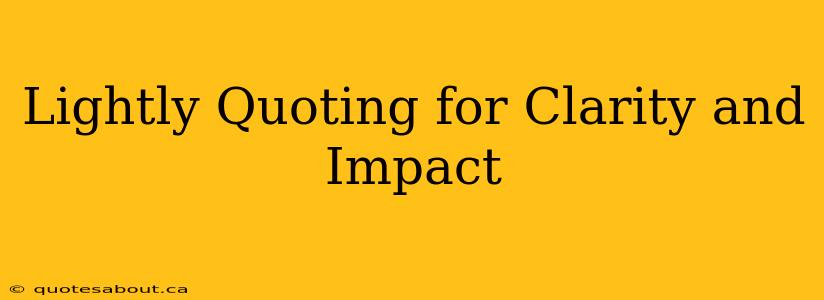Using quotations effectively is crucial for adding weight and credibility to your writing. But sometimes, a full quote can be cumbersome or disrupt the flow of your piece. This is where the art of lightly quoting comes in—selectively incorporating portions of a quote to emphasize key points and maintain a natural, engaging reading experience. This technique is particularly valuable in blog posts, articles, and essays where concise communication is key.
Why Use Lightly Quoting?
Lightly quoting allows you to seamlessly integrate the essence of a source's message into your own writing without overwhelming the reader with lengthy, verbatim excerpts. It helps you:
- Maintain a natural writing style: Avoid jarring transitions and lengthy block quotes that can break up the flow of your text.
- Highlight key phrases: Focus attention on the most impactful words or ideas from the source.
- Add credibility and authority: Still cite your source while avoiding lengthy transcriptions.
- Adapt the quote to your style: Infuse the quoted material with your own voice and perspective.
Techniques for Lightly Quoting
Several techniques can help you effectively use partial quotations:
-
Ellipses (...): Use ellipses to indicate omitted words within a quote. This allows you to extract only the most relevant portion, maintaining the original meaning while keeping your text concise. For example: "The project was… ultimately successful, exceeding expectations."
-
Brackets [ ]: Use brackets to add clarifying words or to change the tense or pronoun for grammatical consistency. This ensures the quote fits seamlessly within the structure of your sentence. For example: "According to the report, 'The results [were] exceptionally positive.'"
-
Integrating phrases: Instead of embedding a whole quote, strategically incorporate key phrases into your own sentences. This creates a more fluid, less fragmented writing style. For example: "Smith's analysis highlighted the 'critical need for… sustainable practices,' a point often overlooked in previous studies."
-
Combining light quotes with paraphrasing: Combine small, carefully chosen quotes with your own paraphrasing to summarize a larger idea or argument. This offers a balanced approach, maximizing clarity and impact.
When NOT to Lightly Quote
While lightly quoting is often helpful, it's important to understand when it might not be the best approach:
- When precision is paramount: In academic writing or legal contexts, precise wording is crucial. Extensive light quoting may compromise accuracy and could lead to misinterpretations.
- When the original phrasing is essential: If the author's unique wording is vital to the argument or analysis, a full quote may be necessary.
- When the quote is already concise: If the quote is already short and to the point, a full quote may be simpler and more straightforward.
How to Attribute Lightly Quoted Material
Proper attribution is crucial regardless of how much of the quote you use. Always cite your source using appropriate formatting (MLA, APA, Chicago, etc.) to avoid plagiarism. Even a lightly quoted phrase requires a citation.
FAQs on Lightly Quoting
Is lightly quoting considered plagiarism?
No, lightly quoting is not considered plagiarism as long as you correctly attribute the source. Using ellipses and brackets to modify the quote should be clearly indicated and the source cited.
How much of a quote can I omit before it becomes plagiarism?
There's no hard and fast rule. The key is whether you’ve maintained the original meaning and accurately represented the author's intent. If your changes significantly alter the meaning, you should paraphrase instead.
What are the best practices for lightly quoting?
Maintain the original meaning, use ellipses and brackets correctly, cite your source consistently, and always prioritize accuracy and transparency.
By mastering the art of lightly quoting, you can enrich your writing with the authority of direct quotes while maintaining a fluid, engaging style. Remember that effective quoting is all about balance—finding the sweet spot between incorporating insightful source material and expressing your own ideas clearly and concisely.

